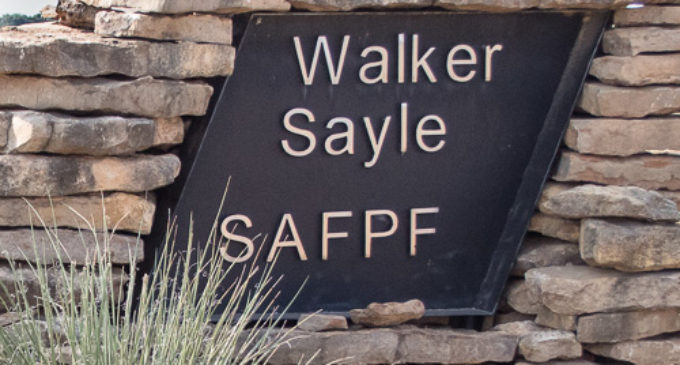City Commissioners continue review of Walker Sayle water rates

Acting on a previous request from the mayor, Breckenridge City Manager Andy McCuistion presented a rate analysis of water and sewer rates the city charges the Walker Sayle prison unit, during last week’s City Commission meeting.
He included three different options for rate reductions the city could make to the rates and the effects those reductions would have on city revenues.
During the September meeting, Mayor Jimmy McKay and Breckenridge City Commissioners requested McCuistion gather more information on the financial effect on city revenues that decreasing the water and sewer rates charged to the Walker Sayle Unit. They wanted to look at bringing the rates more in line with what other cities in the state charge for water rates at similar-sized correctional units.
Also during the September meeting, Breckenridge Economic Development Corporation Executive Director Virgil Moore suggested a target rate similar to that which the Halbert Unit in Burnet County pays. McCuistion said the Halbert Unit, which is a Substance Abuse Felony Punishment Facility like Walker Sayle, pays $6.20 per thousand gallons of water.
McCuistion said the city was looking at reducing the rates as a preemptive move to help make sure the prison wouldn’t be a target for closing if the Texas legislature started closing prisons to save money.
As reported Sept. 12 on the Breckenridge Texan website, Robert Hurst, a spokesperson with the TDCJ in Huntsville, said in an email that there has been no discussion regarding the closure of the Walker Sayle Unit.
According to McCuistion’s report, the Walker Sayle Unit uses almost 17,400,000 gallons of water annually. It shows on March 14, 2017, the city was charging the prison a rate of $10 per thousand gallons at an annual cost of $173,920 to the prison. That rate had been put in place during the drought. Then, on April 19, 2017, the report showed the facility paying a lower rate of $8.60 per thousand gallons which was put in place after the drought ended and city commission reduced the rate. That rate cut produced a decline in annual water revenue to the city of $24,348.80.
Along with showing the effects the different proposed rate cuts would have on the city’s revenue, McCuistion also presented commissioners with chart showing a comparison of rates 10 different correction units are paying that he had been provided with by the warden at Walker Sayle to be used for comparison.
McCuistion’s projections showed that if the city reduced its rate to the $6.20 rate the Halbert Unit pays, the revenue lost to the city would be an additional $41,740.80 annually for a total cumulative loss of $66,089.60 annually from the $10 rate the city was charging in March 2017.
McCuistion said while the city has the ability to reduce rates to that level, cash flow is a concern. He said financially this has been the most difficult year of the last five, and the city is still recovering.
The two other proposed rates McCuistion presented commissioners were $7.60 per 1000 gallons, which results in a $17,392 annual loss of revenue for a total cumulative loss of $41,740.80, and $6.60 rate, which results in $6,956.80 loss or a cumulative loss of $59,132.80.
McCuistion also presented commissioners with projections for rate cuts on sewer rates to the facility and the effects they would have on the city’s revenue. Currently, the city is charging the prison $5.05 per thousand gallons, producing $87,830 in annual revenue to the city. Reducing the rate to $4.80 per thousand gallons would reduce the city’s revenue by $4,348.40. Cutting the rate to $4.55 would reduce it another $4,348.40 for a cumulative $8,696.40 loss, and a cut to $4.30 for another $4,348.80 or cumulative $13,044.40 loss of revenue for the city.
McCuistion told commissioners he organized the rate reduction projections on the chart in way they could mix and match the water and sewer rates and see the effects it would have on the city’s revenue. But, he cautioned that the water fund is already showing a deficit for the year and they need to take that in to consideration as they consider the amount of any rate cuts.
“This year, if you looked at the budget in the water fund, we are spending $177,000 more than we’re bringing in. So we’re already having a deficit budget, except for our reserves,” he said. “We’re taking $177,000 out of our reserves this year just to fund the projects this year. Anything that you continue to take out of there will increase that $177,000 and will reduce our reserves in the water fund.”
When asked about the future projections on water revenues, McCuistion said that because of the recent rains, the city didn’t make the revenue projections this year. He said the rains are a good thing and it helped the citizens not use as much water. However, he said, whenever you project a certain amount of water revenue based on historical usage or, what you think might happen, there are always risks. He said if the current water revenues come in, the city will be all right; and, if there’s little bit of a dry year, then revenues will go up.
The city manager said that on the general fund side of revenues, the city started off the year pretty good. He said two building permits have been presented to him for review, one for a $500,000 project and another for a $60,000 project.
He also said sales tax revenues have been up during the past four months.
“It’s not a lot. It’s up over a bad year – last year was a bad year – but it’s still trending positive,” McCuistion said. “I’m encouraged about that.”
He said that based on recent media reports, he is expecting a 3 percent or more growth rate in the economy. He said he isn’t sure what it was going to do in the oil field and the local economy, but the sales tax revenue is up and that is encouraging.
At the end of the discussion, commissioners voted to continue reviewing the water and sewer rates. They noted that it will be two more years before the legislature meets again and can make any changes to prison closures, so they will have time to take action on changing the rates.
Story by Tony Pilkington/Breckenridge Texan


























































































